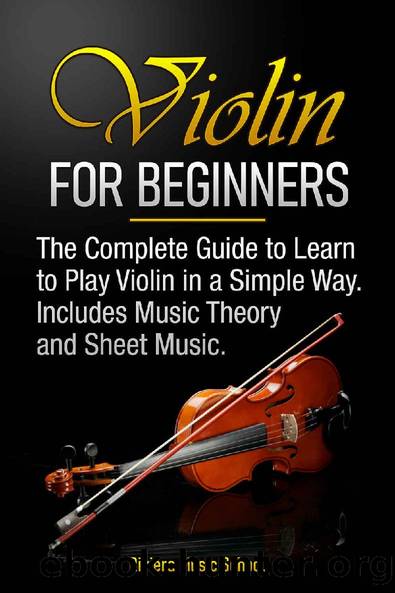Violin for Beginners: The Complete Guide to Learn to Play Violin in a Simple Way. Includes Music Theory and Sheet Music by Riviera Music School

Author:Riviera Music School
Language: eng
Format: epub
Published: 2020-07-01T00:00:00+00:00
Beam up! As should be obvious with that above model, things can begin to get a touch of befuddling when there are many notes on the page that way. Your eyes begin to cross, and you forget about where you were. To assemble notes into smaller bundles that bode well outwardly, we use radiating.
Radiating only replaces singular note banners with thick lines drawn between note stems. These are assembled sensibly and keeping in mind that increasingly unpredictable music requires progressively complex radiating standards, for our motivations, we'll shift in gatherings of quarter notes. Contrast the model beneath and the model above. Give tapping a shot to the beat once more and see how much clearer radiating makes the documentation.
Learn the value of ties and dots. Where a flag will cut the estimation of a note into equal parts, the dot has a comparative work. With constrained special cases the dot is constantly positioned to one side of the note head. At the point when you see a spotted note, that note is expanded by one a large portion of the length of its unique worth.
For example, a dot put after a half note (least) will be equivalent to the half note in addition to a quarter note. A dot set after a quarter note (crotchet) will be equivalent to a quarter note in addition to an eighth note.
Ties are like dotsâthey broaden the estimation of the first note. A tie is just two notes connected along with a bent line between the note heads. In contrast to specks, which are unique and dependent on the estimation of the first note, ties are unequivocal: the note is expanded long by precisely as long as the subsequent note esteem.
One reason you would use a tie versus a spot is, for instance, when a note's term would not fit musically into the space of a measure (bar). You essentially include the extra span into the following measure as a note and tie the two together.
Note that the tie is attracted from note head to note head the other way as the stem.
Download
This site does not store any files on its server. We only index and link to content provided by other sites. Please contact the content providers to delete copyright contents if any and email us, we'll remove relevant links or contents immediately.
| Biographies | Business |
| History & Criticism | Instruments |
| Musical Genres | Recording & Sound |
| Reference | Songbooks |
| Theory, Composition & Performance |
The Goal (Off-Campus #4) by Elle Kennedy(13213)
Kathy Andrews Collection by Kathy Andrews(11345)
Diary of a Player by Brad Paisley(7272)
What Does This Button Do? by Bruce Dickinson(5938)
Assassin’s Fate by Robin Hobb(5867)
Big Little Lies by Liane Moriarty(5528)
Altered Sensations by David Pantalony(4877)
Pale Blue Dot by Carl Sagan(4632)
Sticky Fingers by Joe Hagan(3917)
The Death of the Heart by Elizabeth Bowen(3348)
The Heroin Diaries by Nikki Sixx(3328)
Beneath These Shadows by Meghan March(3157)
Confessions of a Video Vixen by Karrine Steffans(3109)
The Help by Kathryn Stockett(3024)
How Music Works by David Byrne(2969)
Jam by Jam (epub)(2882)
Harry Potter 4 - Harry Potter and The Goblet of Fire by J.K.Rowling(2818)
Strange Fascination: David Bowie: The Definitive Story by David Buckley(2704)
Petty: The Biography by Warren Zanes(2579)
